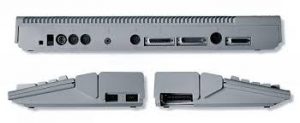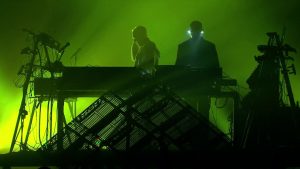A groundbreaking computer for music-making.
When it came to digital audio production It’s fair to say that the Atari ST Computer was groundbreaking. At a time when you needed special hardware like an instrument or hardware sequencer to sequence sounds into songs, the Atari ST allowed people to make music and sequences with a home computer.
What made it special
 The ST’s game-changer was the inclusion of two sockets to its rear, labelled “MIDI”. For most people these were just another couple of ports that would never be employed in their day-to-day lives; for a wannabe bedroom electronic dance music producer this meant connecting our computer with other devices using MIDI technology!
The ST’s game-changer was the inclusion of two sockets to its rear, labelled “MIDI”. For most people these were just another couple of ports that would never be employed in their day-to-day lives; for a wannabe bedroom electronic dance music producer this meant connecting our computer with other devices using MIDI technology!
I had an Atari 1040ST, which offered 1MB of RAM and was double the size compared to its former little brother. The onboard floppy disk drive accepted 3.5″ diskettes that whirred for about a minute and a half with each loading program.
Opening doors to superstardom
What made this set-up so powerful was that if you had a synth or sampler with midi in you could load a sequencing programme into the Atari, I used a programme called Breaktweaker. By today’s standards, it was very basic but at the time it allowed me to get the musical ideas in my head into my ST. If your external instrument was multi-timbral it meant that you had 16 tracks to play with. Enough to put together a track. Connected your instrument to a four-track tape deck and that was it. You could make and record a track all in the comfort of your bedroom and send the demo off to a record company and wait for the phone to ring, no email in those days.

Many did. Orbital, one of the leading Dance acts of the 90s made their breakthrough single Chime at home. It cost £1 to produce, got them on TOTP and headlining Glastonbury blowing the crowd away with their euphoric brand of acid-based dance.
The Atari ST and Me.
The beginning of a love affair with electronic music production
The ST had been out a few years before I started my music-making journey. It was the computer of choice for many electronic musicians so I jumped right in. I had no experience with MIDI and little knowledge of how it all worked. This was back in the day before YouTube and online tutorials but there was a great publication called Future Music which became my bible. I slowly started to work it all out
It seemed that the killer combo was to team up the Atari ST with a sampler such as the Akai S1000, Roland or an Ensoniq ASR 10 which was the route I took. The sampler was such a versatile instrument. You were only limited by your creativity and the small, memory capacity. My ASR 10 had 16 meg available. These days I have unlimited capacity but I cannot honestly say if what I produce now is a lot better than what I came up with on my limited set-up. Being constrained made you think creatively. That mindset has stayed with me ever since and influences the way that I build my tracks with today’s tools
I used to make small sequences on my Atari and then transfer these via Midi to my ASR10 which had an onboard 8 track sequencer that was rock solid. I would take my ASR 10 out and play these dodgy underground clubs that went on all night and everyone was off their heads. What a blast.
For some reason that I cannot remember I never once recorded anything or made a demo. Maybe because I was smoking far too much weed at the time.
Eventually, my Atari gave of the ghost, strangely at about the time that I took a break from music production. I love my set-up with my Powerful Mac and software that can do things that I couldn’t imagine possible back in the day.

